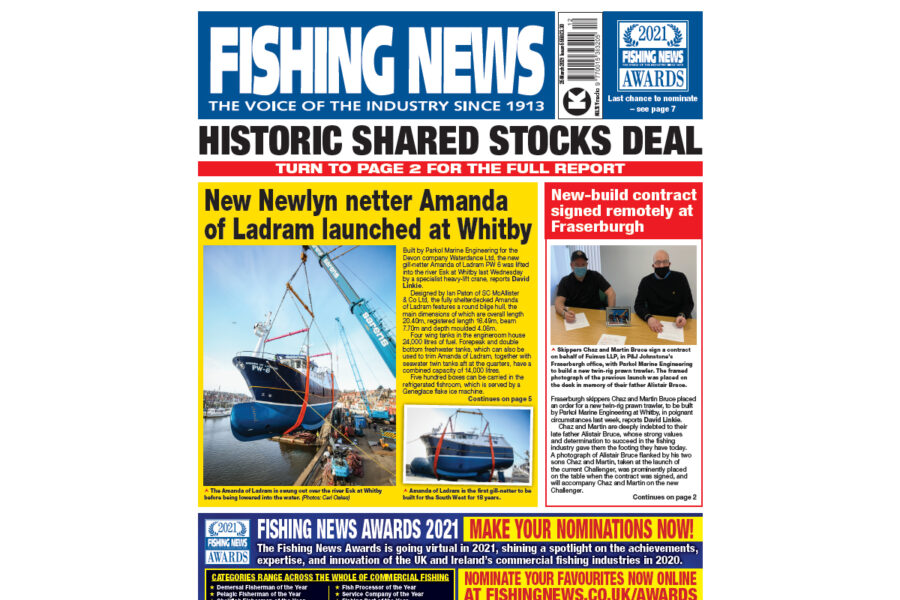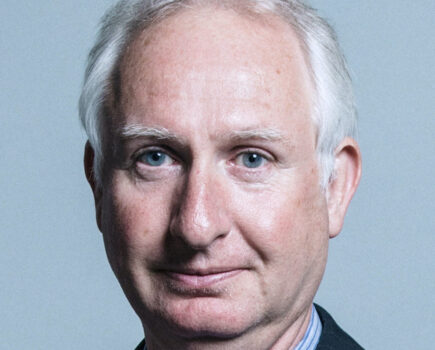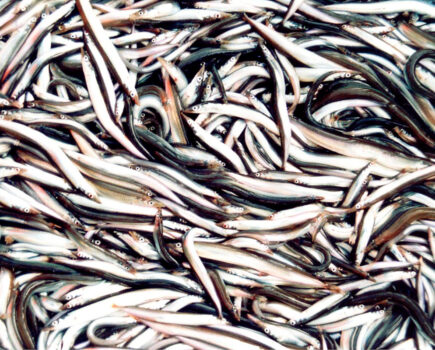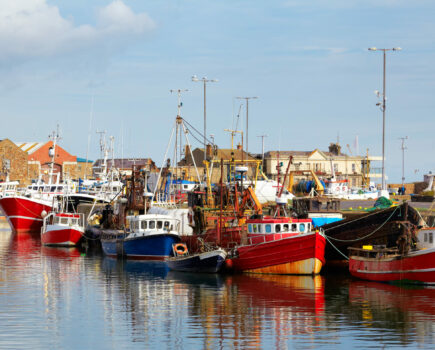UK, Norway and EU agree TACs for shared N Sea stocks
Big cuts in cod and saithe but more haddock and whiting
The UK agreed its first deal as an independent coastal state on Tuesday last week when it reached agreement with Norway and the EU on 2021 TACs for six jointly managed stocks in the North Sea, reports Tim Oliver.
The stocks are 636,000t of cod, haddock, saithe, whiting, plaice and herring, and the TACs agreed are worth over £184m to the UK industry.
Five out of the six stocks have been set in line with, or lower than, the catch levels advised by ICES. This results in reductions for North Sea cod (-10%), plaice (-2%), saithe (-25%) and herring (-7.4%) compared with 2020, but in increases in haddock (+20%) and whiting (+19%).
North Sea cod will be subject to a slightly smaller reduction than the -16.5% recommended by ICES, which will mean a TAC of 15,911t.
The three parties supported this approach as it will allow the stock to recover at a similar pace to that set out in the scientific advice.
The cod TAC is accompanied by the UK’s ongoing cod avoidance plan, which applies to all vessels fishing in UK waters and establishes measures to support long-term cod recovery. Measures include real-time closures to protect high abundances of cod and selective fishing gear.
The EU will also continue to implement its specific control and inspection programme to further reduce catches of younger stock, and the three parties have also agreed to co-operate on monitoring, control and surveillance.
DEFRA said that the UK has pressed throughout the negotiations for TACs to be set sustainably to ensure the long-term future of the fisheries industry.
Fisheries minister Victoria Prentis said: “Today we successfully concluded the first trilateral fisheries negotiations between the UK, EU and Norway.
“As an independent coastal state, we are committed to managing our fisheries sustainably, to the benefit of the fishing industry across the UK and our marine environment, now and in the years to come.”
UK government minister for Scotland David Duguid said the agreement gave increases in haddock and whiting and safeguarded the long-term viability of other key stocks such as cod.
“We remain committed to supporting the industry and being a champion for our coastal communities on the world stage,” he said.
The UK government said it had worked closely throughout the negotiations with the Scottish government and other administrations.
In parallel, the EU and Norway have concluded bilateral consultations for the shared stocks in the North Sea and Skagerrak and on quota exchanges.
The UK is continuing bilateral negotiations with the EU, Faroe and Norway to confirm access arrangements and quota exchanges, where applicable.
Whole deal needed by 31 March
In terms of the continuing bilateral negotiations the UK is conducting with Norway, the EU and Faroe, Mike Park said there were issues relating to access in the Norwegian and Faroe talks and how this would be paid for.
The EU was also ‘pushing back on a number of things in relation to the TCA [Brexit deal]’.
“Obviously the first year of the discussions are going to have their own unique dynamic. The hope is that once we get over this initial annual negotiation, things will get slightly easier,” he said.
“There was always going to be pressure, because whereas you would normally start these negotiations in the autumn, you’re only starting in January. We’ll probably be starting negotiations for next year in four or five months from now.”
He said the end of March was a ‘natural cut-off date’ to reach agreement because it was the end of the first period of provisional quotas, and nobody wanted to move into a second period of provisional allocations.
“It’s not good for the operational management of the fleet. Some species you catch the majority of it in the first three months, or a significant part of it such as whiting, but you only have a small allocation of it for that quarter of the year.
“It’s an unnatural barrier in the management of the fisheries business.”
He said UK access to the Norwegian sector will only come on the back of agreeing a total package deal.
A deal with Faroe was also important, he said, because about 12 of the bigger Scottish vessels fish there at different times of the year, catching about 3,000t cod, haddock, saithe and other species, which reduced the pressure on Scottish waters and quotas.
“This is valuable quota to us when we’re feeling the pain of restrictions,” he said.
Industry: ‘Cod is abundant and science is flawed’
Industry reaction to the deal was that the cod TAC does not reflect the reality of the abundance of cod in the northern North Sea, which the science does not take into account, and that this would make for a very difficult year in the mixed fisheries of the region.
The Shetland Fishermen’s Association (SFA) said that the TAC decisions had been made on a ‘flawed basis’ and did not acknowledge the northern shift in North Sea cod.
SFA chairman James Anderson said: “We knew as soon as the scientific advice was issued last year that the outlook for cod and saithe in particular was very difficult.
“Cod has already been cut savagely (-33% in 2019, -50% in 2020), reflecting the fact that the science has not caught up with a northerly movement in the distribution of the cod stock.”
He said the ICES stock assessment process still focuses on a lack of cod in the southern North Sea, and takes no account of its abundance in the northern North Sea, and particularly around Shetland.
“It leaves the industry in an unnecessarily difficult situation – we are facing steep cuts in quota for a stock that is virtually impossible to avoid in our mixed fisheries,” said the SFA chairman.
Mike Park, chief executive of the Scottish White Fish Producers’ Association (SWFPA), said the outcome was ‘disappointing’ and did not reflect the reality of cod abundance on the grounds.
He said the low cod TAC had also held back the haddock TAC, even though haddock is healthy, because the fisheries managers don’t want the TACs for the two species to be too far out of line with each other. “It’s all interconnected,” he said.
“The current modelling doesn’t reflect the significant northern shift in the distribution of cod – it’s moved 200km north in the last decade or so.”
Skippers were going to be restricted to only small catches of cod or by-catches in the whole region, including the west coast, and it was going to be ‘a very difficult year’, he said.
“Vast areas of the Norwegian zone will also be closed from 1 July to protect spawning cod, and these are areas where we also catch haddock.
“Fishermen are starting to get hemmed in in terms of the activity that they can pursue and the mix of fish that they can catch.”
SFA executive officer Simon Collins noted that ICES is to review the state of cod science this year. “We might hope for more accurate recommendations following that exercise, and of course the UK is now able to take an independent view of scientific advice outside the CFP, but it will all be too late for this year.”
He said that the gains in quota share from Brexit were not enough to make up for the cut in cod quota. “Without full control of access to our waters, we have had little leverage to match quotas with what we are seeing on the fishing grounds.
“In the circumstances, with few cards to play, Scottish government negotiators worked hard to deliver quotas for these species that would undoubtedly have been worse for us if we had still been in the EU and this had been the usual EU-Norway bilateral.”








